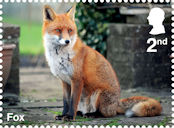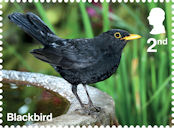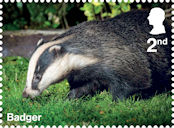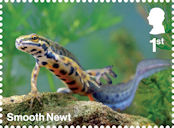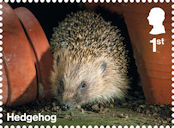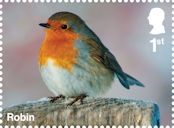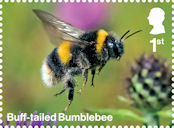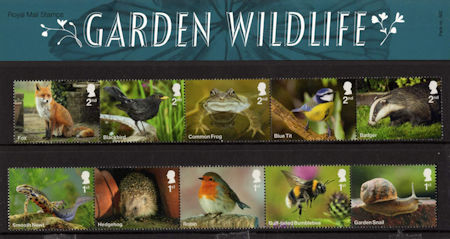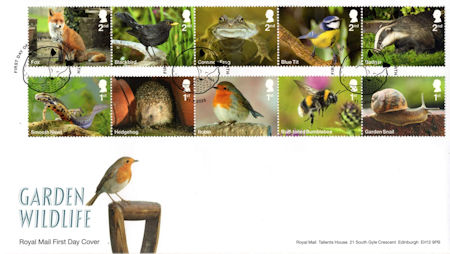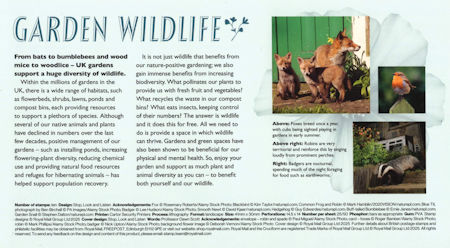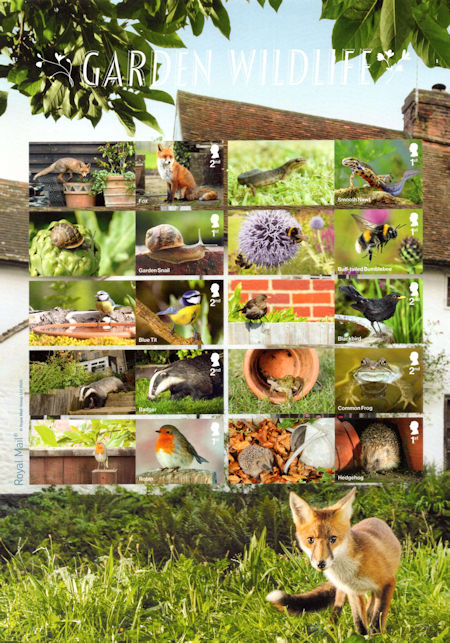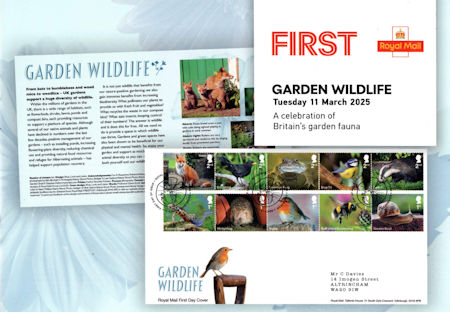Garden Wildlife
2025 (March 11 2025)Commemorative
Designed by Stop, Look and Listen
Size 41mm (h) x 30mm (v)
Printed by Cartor Security Print
Print Process Lithography
Perforations 14.5 x 14
Gum PVA
Stamps
Fox
2ndVulpes vulpes Also known as the red fox, this iconic omnivorous carnivore is widespread across the UK and commonly seen in gardens but, due to its adaptability, also occurs in many different habitats, from oasts to uplands. It has distinctive reddish-orange fur with white on the neck and belly, black on the legs and a thick, bushy tail. Foxes are generalists, having a wide diet that includes insects, fruit, small mammals and leftovers put out for them. They breed once a year, with cubs being sighted playing in gardens in early summer
Blackbird
2ndTurdus merula Blackbirds are found widely across the UK, from gardens to countryside, coasts to hills. They are common and easily recognisable garden visitors. The males are black with bright orange-yellow beaks and yellow eye-rings, whereas females are brown, often with spots and streaks on their breasts, and brown beaks. Blackbirds feed on a variety of insects, worms and molluscs, also eating berries and fruit when in season. They forage mostly on the ground, turning over leaf litter and probing the soil for food.
Common Frog
2ndRana temporaria Widespread in mainland Britain, frogs are found in damp habitats including gardens with ponds. They have smooth skin – grey, olive-green and yellow-to-brown in colour – with irregular dark blotches and a dark stripe around their eyes. Frogs are mainly active at night and eat insects (using their long, sticky tongues), as well as snails, slugs and worms. In spring, males call to attract females to breed. Frogs lay large clumps of black-dotted jelly frogspawn in shallow water. Young tadpoles feed on algae, but then become carnivorous.
Blue Tit
2ndCyanistes caeruleus Possessing distinctive blue-and-white heads, with black eye-stripes and yellow breasts, blue tits are one of our most familiar garden visitors. They are common in woodland, hedgerows, parks and gardens, feeding on insects, seeds and nuts. It is estimated that over 15 million blue tits overwinter in the UK, with numbers recently increasing, possibly due to supplementary food and bird-box provisions in gardens. They are considered strictly ‘residential’ birds, rarely moving far from where they hatch.
Badger
2ndMeles meles With their unique black-and-white face markings, and being the largest native land carnivores in the UK, badgers (also known as European or Eurasian badgers) are easily recognisable. They are members of the mustelid family, closely related to otters, stoats and weasels. Badgers live in groups called clans, based in underground setts. They are nocturnal, spending much of the night foraging for food. Although their diet can be wide-ranging, badgers do have a liking for earthworms and can eat over 200 in a night.
Smooth Newt
1stLissotriton vulgaris Also known as the common newt, this species is widespread and often found in garden ponds or in habitats such as woodpiles and rockeries. They feed on insects, slugs and worms on land, and hunt invertebrates and frog tadpoles in the water. Both males and females are grey or brown in colour and have an orange or yellow belly with black spots that extend up to the throat. During the breeding season, males develop a wavy crest along their body and tail. Females lay their eggs individually and wrap them in aquatic plant leaves for protection
Hedgehog
1stErinaceus europaeus Garden visitors that have been voted Britain’s favourite mammal, hedgehogs were once widespread across the UK in woodland, arable land, hedgerows and grassland, but have recently suffered population declines. Unmistakable in appearance, hedgehogs (also known as European hedgehogs) have several thousand spines across their backs, and pointed furry faces with small black eyes and investigative noses. Known as ‘gardeners’ friends’ due to their diet of slugs, snails, beetles and caterpillars, hedgehogs hibernate from around November to April. In gardens, this can happen in piles of leaves or logs, in compost heaps and under sheds.
Robin
1stErithacus rubecula With their highly distinctive red breasts, contrasting with brown bodies and white undersides, robins have been named the UK’s favourite birds. Found in a range of habitats, and common in gardens, robins are known to follow gardeners, hoovering up insects and worms that have been unearthed, although they also feed on seeds, fruits and other invertebrates. Males and females are identical in appearance. They are aggressively territorial and reinforce this by singing loudly from prominent perches.
Buff-tailed Bumblebee
1stBombus terrestris The buff-tailed bumblebee is a common and widespread species found in gardens, parks and lowland areas throughout the UK. It is a large bumblebee, with yellow bands at the collar and on the abdomen. It feeds on a wide range of flowers such as lavenders, thistles and daisy-like species where its short tongue can easily reach the available nectar. The species is named after the buff-coloured tail of the queen, although workers and males have an almost white tail, often with a narrow buff-coloured line between the black abdomen and tail.
Garden Snail
1stCornu aspersum Some of the most widespread garden animals, snails have pale-grey skin and brown or yellowish shells with pale flecking and dark spiralling bands. They are active at night, feeding on leaves, fungi and plant debris. Garden snails generally hibernate during winter. After mating, they lay around 80 white eggs in an underground nest. The newly hatched snails have fragile shells and take about two years to mature. Snails are hermaphrodites, having both female and male reproductive cells, meaning they can also reproduce by self-fertilisation.
Publicity - First
PHQ Cards
Pack PHQ543
RM Code AQ365
5014721162966











